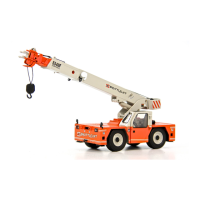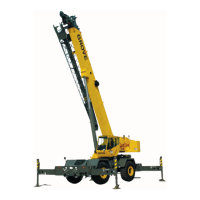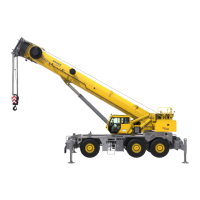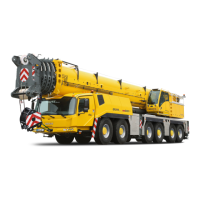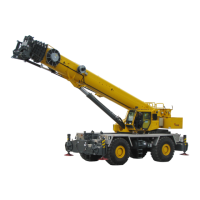TRANSMISSION AND TORQUE CONVERTER CD3340B/YB4411
7-26
Published 04/07/2015 Control # 569-00
Converter In Pressure
See Figure 7-13.
1. Connect a 0-20 bar (0-300 psi) pressure gauge to test
point B.
2. Install a load valve P into the converter out line.
NOTE: Make sure the load valve is in the OPEN position
(the adjusting knob screwed fully out) before
starting the following pressure test. If the load valve
is not fully open, damage to the converter seals will
occur.
NOTE: DO NOT allow the pressure to exceed 110 bar (150
psi) or damage to the converter seals will occur.
3. Start the engine and run at 1000 rpm. With the
transmission in neutral, slowly screw down the load
valve P while observing the gauge reading which should
rise to the converter relief valve setting specified.
4. If the reading is higher than specified the converter relief
valve is faulty. A low reading indicates a leaking pump
seal or faulty converter relief valve.
5. Stop the engine and remove the test gauges and install
hoses to original position.
Lubricating Pressure
See Figure 7-13.
1. Stop the engine and connect a suitable pressure gauge
into the return line from the oil cooler to the transmission
as shown in J.
2. Start the engine and run at 1000 rpm. With the
transmission in neutral, the pressure gauge will indicate
the lubricating pressure. Compare the pressure reading
with the specifications on page 7-2.
3. Repeat step 2 and note the pressure with the engine
running at 2000 rpm.
4. Stop the engine and remove the pressure gauge.
Transmission Repair
Special Service Tools
FIGURE 7-15
P/N 1900449
a0254
End Float Setting Tool
FIGURE 7-16
P/N 1001834
a0249
Reverse Clutch End Float
Setting Tool
FIGURE 7-17
P/N 1001833
a1397
End Float Setting Tool
FIGURE 7-18
P/N 1900365
a0180
Drive Coupling Spanner For
Yoke Couplings
FIGURE 7-19
P/N 1903746
a1411
Mainshaft Air Line Adapter
Reference Only
